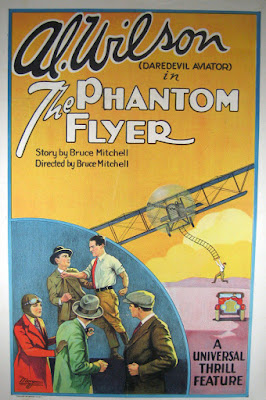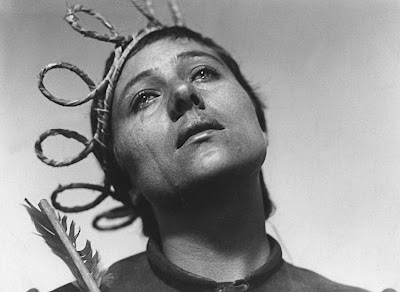On Saturday night, it's Keaton's 'The Cameraman' (1928) at Northeast Catholic College way up in Warner, N.H.
And then on Sunday, it's the original silent film adaptation of 'Peter Pan' (1924) at the Aeronaut Brewing Co. in Somerville, Mass.
Our part of New England is getting a good amount of snow now through Saturday. But that shouldn't impede this pair of silent film shows.
One nice thing about this weekend's screenings has been the publicity.
I always send out press materials, but you never know what will be used, and when, and how.
For this weekend, I've lucked out with some good coverage.
For the Keaton screening, the Concord (N.H.) Monitor, a highly respected daily paper, devoted quite a bit of space to this story. Thanks!
And for the Aeronaut 'Peter Pan' screening, writer Sean Burns did a great job pulling together a fairly lengthy piece, especially by Metro standards.
Also, here's a screen capture of the story in the print edition:
So whether it's country-style silent film you crave, or if you prefer a more urban setting, there's something for every taste this weekend.
Press releases for both films (with a lot more info) are pasted in below. See, I really do send out press materials!
An original poster for Keaton's 'The Cameraman' (1928), running on April Fool's Day (Saturday, April 1) at Northeast Catholic College.
TUESDAY, MARCH 14, 2017 / FOR IMMEDIATE RELEASE
Contact Jeff Rapsis • (603) 236-9237 • jeffrapsis@gmail.com
Buster Keaton's 'The Cameraman' at Northeast Catholic on Saturday, April 1
Classic silent film comedy masterpiece to be screened with live music; program open to the public
WARNER, N.H. — Silent film with live music returns to the big screen at Northeast Catholic College in April with a showing of an acclaimed comedy starring Buster Keaton.
The screening, on Saturday, April 1 at 7 p.m., will feature Keaton's classic comedy 'The Cameraman' (1928). Admission is free for Northeast Catholic students and any others with college ID; general public admission is $5 per person
Live music will be provided by silent film accompanist Jeff Rapsis. The program will include a short comedy, 'Cops,' also starring Buster Keaton.
'The Cameraman' tells the story of a young man (Keaton) who tries to impress the girl of his dreams (Marceline Day) by working as a freelance newsreel cameraman. His efforts result in spectacular failure, but then a lucky break gives him an unexpected chance to make his mark. Can he parlay the scoop of the year into a secure job and successful romance?
Buster Keaton's self-referential world of 'The Cameraman.'
In 'The Cameraman,' Keaton uses the movie business to create comedy that plays with the nature of film and reality. The movie contains classic sequences often cited as among Keaton's best.
Keaton, along with Charlie Chaplin and Harold Lloyd, stands as one of the three great clowns of the silent screen. Many critics regard Keaton as the best of all; Roger Ebert wrote in 2002 that "in an extraordinary period from 1920 to 1929, (Keaton) worked without interruption on a series of films that make him, arguably, the greatest actor-director in the history of the movies."
As a performer, Keaton was uniquely suited to the demands of silent comedy. Born in 1895, he made his stage debut as a toddler, joining his family's knockabout vaudeville act and learning to take falls and do acrobatic stunts at an early age. He spent his entire childhood and adolescence on stage, attending school for exactly one day.
A remarkable pantomime artist, Keaton naturally used his whole body to communicate emotions ranging from sadness to surprise. In an era when movies had few special effects, Keaton's acrobatic talents meant he performed all his own stunts.
All those talents are on display in 'The Cameraman,' which was selected in 2005 for preservation in the U.S. National Film Registry by the Library of Congress as being "culturally, historically, or aesthetically significant."
'The Cameraman' will be accompanied by live music by Jeff Rapsis, a New England-based silent film accompanist who performs at venues across the region and beyond.
"These films were created to be shown on the big screen as a sort of communal experience," Rapsis said. "With an audience and live music, they still come to life in the way their makers intended them to.
"So the screening at Northeast Catholic College is a great chance to experience films that first caused people to first fall in love with the movies," he said.
Established as a residential, Catholic liberal arts college in 1973 and located in Warner, N.H., the Northeast Catholic College (formerly the College of Saint Mary Magdalen) seeks to call students to the life-long pursuit of intellectual and moral virtue through the rigorous study and discussion of primary texts and through its vibrantly Catholic student life.
Buster Keaton's 'The Cameraman' (1928) will be screened with live music on Saturday, April 1 at 7 p.m. at Northeast Catholic College (formerly Magdalen College), 511 Kearsarge Mountain Road, Warner, N.H. Admission is free to students with a college ID; general public is $5 per person.
For more information about Northeast Catholic College, visit www.northeastcatholic.edu/ For more info on the music, visit www.jeffrapsis.com.
An original poster for the original screen adaptation of 'Peter Pan' (1924).
WEDNESDAY, MARCH 22, 2017 / FOR IMMEDIATE RELEASE
For more info, contact: Jeff Rapsis • (603) 236-9237 • jeffrapsis@gmail.com
Silent film version of 'Peter Pan' at Aeronaut on Sunday, April 2
Original adaptation of magical fantasy classic to be shown with live musical score
SOMERVILLE, Mass.—It was the film that introduced movie-goers to visions of flying children, magical fairies, human-like animals and menacing pirates.
It was the original silent film adaptation of 'Peter Pan,' a picture personally supervised by author J.M. Barrie. The film was a major hit when released in 1924, with audiences eager to get their first big-screen look at the wonders of Neverland.
Movie fans can see for themselves when the first 'Peter Pan' (1924) is screened on Sunday, April 2 at 7 p.m. at the Aeronaut Brewing Co., 14 Tyler St., Somerville.
The program will feature live music for the movie by silent film accompanist Jeff Rapsis, and will include a classic silent comedy short film. Admission is $10 per person. Tickets are available online at www.eventbrite.com; search on "Aeronaut Brewery."
Thought lost for many years, and overshadowed by more recent adaptations, the original silent 'Peter Pan' maintains its freshness and charm 90 years after its original release.
In the story, first presented as a stage play in 1904, three children in London are visited one night by Peter Pan, a youth in search of his shadow. Pan shows his new friends how to fly, and then convinces them to join him in a journey to Neverland.
There they encounter Indians, mermaids, and a band of pirates whose leader, Captain Hook, is Pan's sworn enemy. The children are captured by Hook and taken prisoner aboard his pirate ship, setting the stage for an epic battle, the outcome of which will determine if the children may ever return home.
Betty Bronson in the title role.
Though the Peter Pan story is well-known today due to subsequent adaptations (and also merchandising that includes a ubiquitous brand of peanut butter), the tale was virtually new when Hollywood first brought it to film in the early 1920s.
In England, author Barrie gave his blessing to the first-ever screen adaptation, though he retained control over casting and insisted that any written titles in the film be taken directly from his own text.
After a major talent search, Barrie settled on unknown 18-year-old actress Betty Bronson for the title role, and filming began in 1924. The role of Captain Hook was played by noted character actor Ernest Torrence, who invented the now-iconic villainous pirate persona that would become a Hollywood legend.
The film's highlights include special effects that maintain their ability to dazzle even today. The film's memorable images include a group of mermaids entering the sea, a miniature Tinkerbell interacting with full-sized children and adults, and a pirate ship lifting out of the water and taking flight.
'Peter Pan' also includes a cast of animal characters played by humans in costume, including the family dog Nana and an alligator who serves as Hook's nemesis, lending the film a magical quality.
After the film's release, no copies of the original 'Peter Pan' were known to exist, and for many years the film was regarded as lost. However, in the 1950s a single surviving print turned up in the George Eastman Archives in Rochester, N.Y., from which all copies today have descended.
Accompanist Jeff Rapsis specializes in creating live musical scores for films made prior to the introduction of recorded sound. Based in New Hampshire, Rapsis specializes in improvising music for silent film screenings at venues ranging from Harvard University in Cambridge, Mass. to the Niles Essanay Silent Film Museum in San Francisco, Calif.
Rapsis creates film scores in real time, as a movie is running, using a digital synthesizer to reproduce the texture of a full orchestra. He averages about 100 performances per year, and has created music for more than 250 different silent feature films.
"Improvising a movie score is a bit of a high wire act, but it can result in music that fits a film's mood and action better than anything that can be written down in advance," Rapsis said. "It also lends a sense of excitement and adventure to the screening, as no two performances are exactly alike."
The screening is part of the Aeronaut's commitment to give local artists and audiences a chance to connect in the brewery's performance space.
Just as beer aficionados appreciate a good hand-crafted brew, movie-goers are rediscovering the joys of silent cinema presented as it was intended: on a big screen, with live music, and with an audience.
"If you can put all the original elements together, the films of early Hollywood still come to life," said Rapsis, who performs regularly at the Aeronaut. "These are the films that caused people to first fall in love with the movies."
‘Peter Pan’ (1924) will be shown on Sunday, April 2 at 7 p.m. at the Aeronaut Brewing Co., 14 Tyler St., Somerville, Mass. Admission is $10 per person. Tickets are available online at www.eventbrite.com; search on "Aeronaut Brewery." For more info about Aeronaut Brewing, visit www.aeronautbrewing.com. For more information about the music, visit www.jeffrapsis.com.



















